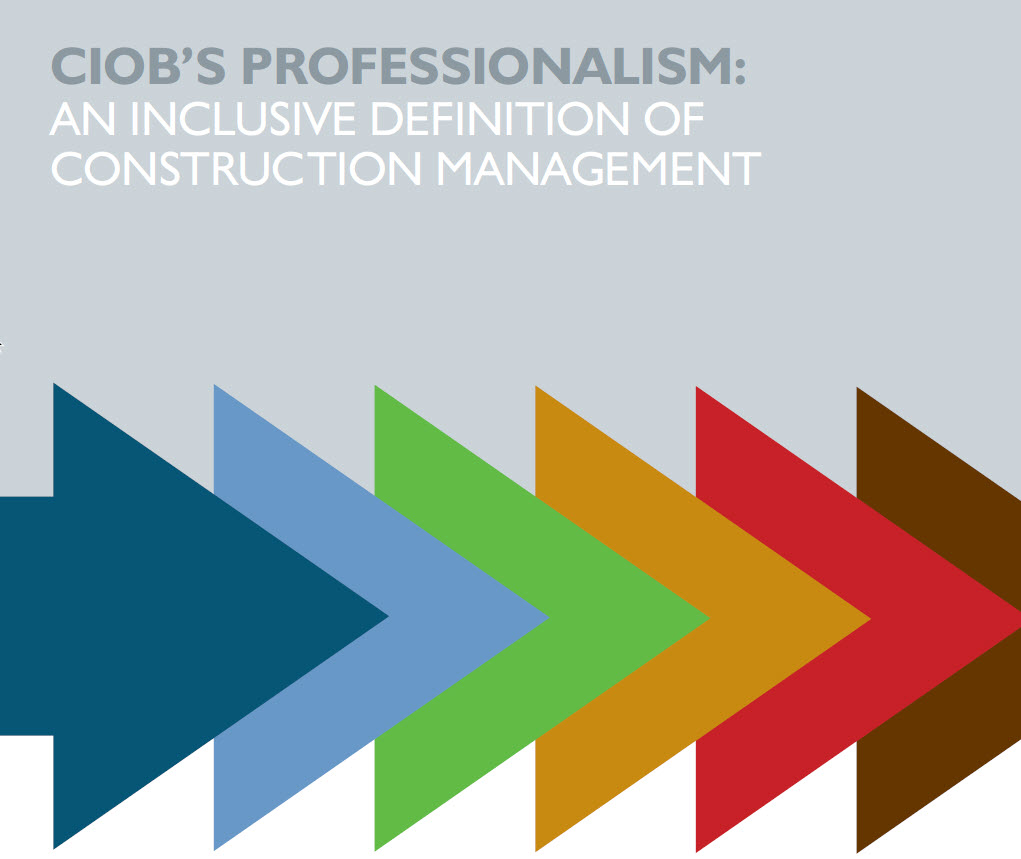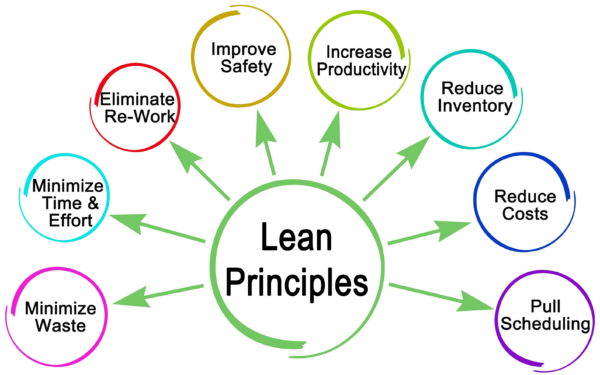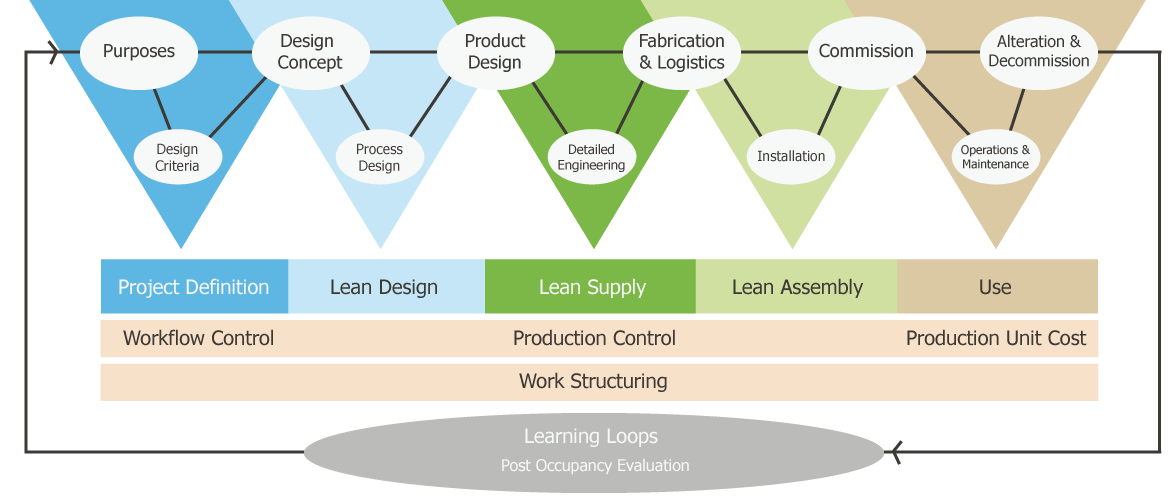Location:
PMKI > IT
& Construction Industries > Construction
Management.


- Improving construction management
- Rethinking
Construction Reports
- Scope for Improvement
Reports
- Project Definition Rating
Index (PDRI)
- Construction Education
- Managing Construction
Stakeholders
- Managing time
- Managing construction risk
- Lean Construction
- Causes of project failure
- Useful External Web-links &
Resources.
Other related sections of the PMKI:
- The history of
construction management
- Building Information
Modelling (BIM)
- Construction &
Engineering Case Studies
- Green building
- CIOB Resources
- Dispute management in
construction/engineering
- Claims and Forensic Analysis
- ADR and Dispute Services
- Casewatch Reports – building
& contract law
Construction management has a very long and complex history, the history section of this website looks at some elements of the evolution of construction and project management over the last 5000 years:
 CIOB's
definition of construction management is: Management
of the development, conservation and improvement of the
built environment; exercised at a variety of levels from
the site and project, through the corporate organizations
of the industry and its clients, to society as a whole;
embracing the entire construction value stream from
inception to recycling, and focusing on a commitment to
sustainable construction; incorporating a wide range of
specialist services; guided by a system of values
demonstrating responsibility to humanity and to the future
of our planet; and informed, supported and challenged by
an independent academic discipline.
CIOB's
definition of construction management is: Management
of the development, conservation and improvement of the
built environment; exercised at a variety of levels from
the site and project, through the corporate organizations
of the industry and its clients, to society as a whole;
embracing the entire construction value stream from
inception to recycling, and focusing on a commitment to
sustainable construction; incorporating a wide range of
specialist services; guided by a system of values
demonstrating responsibility to humanity and to the future
of our planet; and informed, supported and challenged by
an independent academic discipline.
The UK government has commissioned a number of reports
over several decades looking at ways to enhance the
productivity and value delivery capability of the
construction industry. These reports are still a valuable
reference and highlight opportunities for improvement that
still need widespread implementation:
- The Latham report 1994 Constructing the Team © Crown
Copyright: Download
the report (PDF).
- The Eagan Report 1998 Rethinking Construction © Crown
Copyright: Download the report (PDF)
- The benefits and on-going recommendations updated in
Accelerating Change 2002 (Egan & Crane):
Download the report (PDF)
The Australian government issued a similar report in 2022
with virtually identical conclusions, the only significant
difference being a recommendation to use BIM by default -
see more on BIM.
Download Government Procurement A Sovereign
Security Imperative.
Ashurst's* Scope for Improvement series of reports
focused on major Australian construction projects with an
average value in excess of $400 million. Issues identified
included inadequate scoping (on average 20% was omitted
from the contract documents) and inefficient risk
allocation. Almost 50% of the projects finished late
and experienced significant cost overruns, the trend
between 2006 and 2014 was basically a flat line.
Unfortunately, nothing much has changed in the intervening
years and the advice and findings in these reports are
still relevant today.
- 2006 report: Scope for Improvement: A
Survey of Pressure Points in Australian Construction
and Infrastructure Projects
(or,
Download
the 2006 executive summary).
- 2008
report: Report into Project Scoping
-
2011 report: Report into Project Risk - Getting the
Right Balance and Outcomes
- 2014
report: Project Pressure Points - Where Industry Stands
*Note: the earlier reports were by BDW prior to
that firm becoming part of Ashurst.
Blg: Scope for improvement 4. A summary of the 'scope for improvement' reports.
Blg: Scope for improvement 4 pt2. The management and delivery of mega projects in Australia; focused on the interlinked topics of productivity, innovation and training.
Blg: Defining Project Scope. If a project’s client cannot ask for what it needs, the project team is highly unlikely to deliver what’s wanted!
For more on defining and managing scope see: Scope Management.
The PDRI is a tool developed by the Construction Industry
Institute™ that identifies and precisely describes each
critical element in a scope definition package. It is
intended for use during front end planning (FEP)* phase of
a project, encompassing activities such as feasibility,
concept, and detailed scope definition. It also enables
project teams to identify quickly the project risk factors
related to desired outcomes for cost, schedule, and
operating performance. By using the PDRI method, teams can
capture mitigation action items and evaluate the
completeness of scope definition at any point prior to
detailed design and construction. For more on PRDI see:
https://www.construction-institute.org/resources/knowledgebase/pdri-overview.

One key way to improve construction delivery is the continuing education of the construction and engineering management workforce after graduation. A range of organizations offer qualifications including the CIOB and PMI:
 Effective stakeholder
management is mandatory for mega-project success in all
advanced economies and most emerging economies, and is a
vitally important contributor to success in every other
construction project. The ability of people to protest a
new development has increased exponentially with the
advent of mobile communications and social media. In the
21st century, a single dedicated person can quickly
generate a large protest movement. This applies equally to
political, environmental and social movements, and as
construction projects can affect all of these different
aspects, a construction project will inevitably create
some opposition. As Spike Milligan is quoted to have said:
Money can't buy you friends but you can get a better
class of enemy, the larger the project, the more
opponents it is likely to generate.
Effective stakeholder
management is mandatory for mega-project success in all
advanced economies and most emerging economies, and is a
vitally important contributor to success in every other
construction project. The ability of people to protest a
new development has increased exponentially with the
advent of mobile communications and social media. In the
21st century, a single dedicated person can quickly
generate a large protest movement. This applies equally to
political, environmental and social movements, and as
construction projects can affect all of these different
aspects, a construction project will inevitably create
some opposition. As Spike Milligan is quoted to have said:
Money can't buy you friends but you can get a better
class of enemy, the larger the project, the more
opponents it is likely to generate.
Traditional construction management has focused on the ‘iron triangle’ of time, cost and scope. Today this is not enough, ignoring the social aspects of a project will cause the project to fail! And, if the project is sufficiently controversial, the protest movement can quickly spread globally. The only ethical option to minimize opposition is authentic stakeholder engagement. Two tools developed to assist in this process are the Stakeholder Circle® methodology and the SRMM® maturity model. These tools are discussed within the framework of managing construction projects to optimize the stakeholder relationships in and around the project and minimize risk exposures.
Prs: Rethinking
Construction - Stakeholder Management in the
Construction Industry.
Many technically competent builders are failing to
maximize the value of their work to their client
organizations/employers by focusing exclusively on
technology, data and processes. By including an awareness
of communication and relationship management within the
overall matrix of skills used to develop a schedule, cost
plan, etc, the builder can transform the perception of the
documents value from being seen as an ‘administrative
overhead’ into a valuable resource.
To achieve the spread of effective relationships needed to succeed, the builder, must recognize that project teams and senior management have different perceptions, expectations and measures of success and customize his/her communication strategy to meet their different requirements. The relationship aware builder is trusted and relied on by both project teams and senior management, acting as an effective cultural translator between the two groups. Technical competence is still a vital requirement, if this is missing there is no point in communicating, but once the technical issues are conquered the difference between average and exceptional performance is found in the capability of the builder to effectively relate and communicate with his/her stakeholders up and down the organization. This paper outlines a number of techniques and tools, including the Stakeholder Circle® that can be used to identify and map stakeholders, understand their requirements and develop an effective communication plan. See more on the Stakeholder Engagement.
PP:
Mega Projects, Mega Problems - The critical need for
effective stakeholder management.
Effective stakeholder engagement can contribute to a
profitable project outcome, this include stakeholders
within the project team, as well as external stakeholders.
Fortunately for both groups of stakeholders, including both the proponents of the project (supporters) and the opponents of the project, the art of stakeholder management remains the same. The key steps are:
Communication within effective relationships is the only ethical way to change stakeholder perceptions and expectations to the benefit of the project. Supporters need to be encouraged, opponents need to be managed and their opposition minimized. The skill is focusing on the right people at the right time - two tools developed to assist in this process are the Stakeholder Circle® methodology and the SRMM® maturity model.
 Delayed
completion affects IT, process plant, oil and gas,
building, civil engineering, shipbuilding and marine work
contracts. In fact it affects all industries in all
countries and the bigger the project, the more damage
delayed completion causes to costs, to reputation and
sometimes, even to the survival of the contracting parties
themselves. Without effective time management there can be
no effective resource management, cost management, or
delay management. Unfortunately, despite the obviousness
of this proposition, far too many contracts and contract
programs seem designed as highly detailed, ridged
mechanisms for measuring failure; rather than using the
schedule as a tool for proactively managing time to the
benefit of all of the parties to a contract. This
website's primary focus in on making effective use of the
limited time available to complete a project, some
directly relevant sections are:
Delayed
completion affects IT, process plant, oil and gas,
building, civil engineering, shipbuilding and marine work
contracts. In fact it affects all industries in all
countries and the bigger the project, the more damage
delayed completion causes to costs, to reputation and
sometimes, even to the survival of the contracting parties
themselves. Without effective time management there can be
no effective resource management, cost management, or
delay management. Unfortunately, despite the obviousness
of this proposition, far too many contracts and contract
programs seem designed as highly detailed, ridged
mechanisms for measuring failure; rather than using the
schedule as a tool for proactively managing time to the
benefit of all of the parties to a contract. This
website's primary focus in on making effective use of the
limited time available to complete a project, some
directly relevant sections are:
 Easy CPM is
a course-in-a-book that provides practical training and
guidance to individuals and organizations involved in
developing or using CPM schedules based on the Critical
Path Method (CPM). It is designed to act as both a
reference, and practice guide, for people implementing CPM
scheduling after they have learned to use the CPM
scheduling software of their choice.
Easy CPM is
a course-in-a-book that provides practical training and
guidance to individuals and organizations involved in
developing or using CPM schedules based on the Critical
Path Method (CPM). It is designed to act as both a
reference, and practice guide, for people implementing CPM
scheduling after they have learned to use the CPM
scheduling software of their choice.
PP: (The) Effective Management of Time on Mega Projects. Why there are so many problems and how to solve them? - The construction industry’s ability to effectively manage time is getting worse. In response to this challenge, the CIOB assembled an international team of project planning and scheduling experts to develop a Guide to Good Practice in the Management of Time in Complex Projects (the Guide). This paper identifies the key elements within the Guide that proactively contribute to the successful delivery of mega projects, relate these ideas to practical examples of their use on mega-projects and offer a way forward to improve time management.
Prs: Time management -v- Contract administration.
Although much has been written about how to apportion liability for delay after a project has gone wrong there was, until recently, no guidance on how to manage time pro-actively and effectively on complex projects. This paper seeks to address this imbalance by focusing on the effective management of time in the 21st Century. This paper defines the standards by which project schedules should be prepared, quality controlled, updated, reviewed and revised in practice to effectively manage time. And then describes the standards of performance which should reasonably be required of a project scheduler. It will contrast the static approach to scheduling defined in most contracts with The Guide’s logical step by step procedures to manage time from inception and risk appraisal, through design and construction to testing and commissioning, to show how an effective and dynamic time model can be used to manage the risk of delay to completion of complex projects. And will demonstrate that as a practical treatise on the processes to be followed and standards to be achieved in effective management of time, The Guide is a scheduling reference document capable of wide application. It can be used in any jurisdiction, under any form of contract, with any type of project and should be identified as the required standard for the preparation and updating of contract programmes, progress reporting and time management. The
'Scope for Improvement' surveys of major Australian
construction projects with an average value in excess of
$400 million identified the inefficient allocation of risk
as a major factor in project failures. Almost 50% of the
projects finished late and experienced significant cost
overruns,and since these surveys many major contractors
have gone into liquidation.
The
'Scope for Improvement' surveys of major Australian
construction projects with an average value in excess of
$400 million identified the inefficient allocation of risk
as a major factor in project failures. Almost 50% of the
projects finished late and experienced significant cost
overruns,and since these surveys many major contractors
have gone into liquidation.
See more on the Scope for Improvements
reports.
Managing risk is a vital component of project success for both the client and the contractor. See more on risk management. See also Industry Perspectives on Risk.
Geotecnical risk is one significant area of construction risk.
PP: Balanced Baselines - A Fairer Allocation of Uncertain Risks. The use of a Geotechnical Baseline Report (GBR) in the construction contract provides the parties to the contract with a mutual understanding of the subsurface site conditions (the baseline). The actual conditions encountered are measured against this baseline. If the contractor comes across a more adverse condition than that of the baseline, then the owner pays the contractor more to complete the work under those adverse conditions, and if the conditions are less adverse than the baseline, then the contractor is paid no more than that tendered. The reduced risk to the contractor should result in lower tender prices and minimizes the opportunity for contract claims and disputes.
 Lean
construction is a relationship-oriented, production
management-based approach to construction project delivery
that is ideally suited to employ the Project
Controls 3.0 approach to managing the
project.
Lean
construction is a relationship-oriented, production
management-based approach to construction project delivery
that is ideally suited to employ the Project
Controls 3.0 approach to managing the
project.
The Lean Construction Institute (LCI) has developed the Lean Project Delivery System™ (LPDS) that applies lean principles pioneered in manufacturing to construction. The main goals of LPDS are maximizing stakeholder value while minimizing waste. An emphasis on inter-team collaboration means you can reliably release work from one construction process to the next minimizing delay and other waste.
Participants consider the entire project life cycle when deciding how to design and build the project. During the design phase of a lean construction project, the participants consider the entire life cycle of the structure through to the logical conclusion of its life and incorporate lessons from the past at all levels. Feedback and suggestions for improvement are accepted from everyone involved in the project.

During construction, the work is scheduled by applying the Last Planner System, the people doing the work make a firm commitment to complete their tasks in the agreed times, following the requirements. As part of the planning process, work is pulled rather than pushed, which helps reduce work in progress (WIP), increase efficiency, and reduce waste.
Blg: A focus on Work-Flow Little’s Law suggests that any increase in WIP automatically increases lead times! To borrow from Lean: WIP is a waste and needs to be minimized. This post explains the concept of queuing theory used in PC-3.0.
Blg:
Learning from Lean Construction The concepts
embedded in Lean Construction, supported by PC-3.0 are
applicable to a very wide range of project types in
addition to its roots in construction:
- Sustainability: focus on the whole of life, not
just the immediate short term.
- Efficiency: work collaboratively to avoid
unnecessary waste.
- Work effectively: keep everyone engaged and
working efficiently.
- Adaptability: work to keep improving the overall
outcomes.
- Maintain overall control: use control systems that
facilitate adaptability in the current work, while
maintaining a clear overall picture of where the project
is heading (PC-3.0).
Produced by the Lean Construction Institute Standards
Committee, LPS® is a set of 12 documents to guide
superintendents, foremen and project teams to effective
LPS® implementation – see more on Last Planner. LPS®
relies on getting at least one representative from each
crew into the same room (physically or digitally) and
getting their input into the planning process. This
improve the plans by including the perspectives of people
who are going to be doing the work, and shifts the dynamic
of the process. People are part of a team with an
understanding of how their work fits into the project,
which usually makes them more likely to increase their
productivity and help generate solutions for conflicts and
delays.
Pull planning defines key project milestones and plans backward from them, which can help identify inefficiencies and detect potential delays. Pull planning uses LPS® to enlist the help of team members in the process, which improves the quality of the plan by including their expertise and increases their understanding of how their work connects to the work of others. The Pull Planning Process uses the following steps:
Both Last Planner and Pull Planning are compatible with the Project Controls 3.0 approach and can be used for a single Work Unit (project phase) or the whole project.
This section looks at some of the specific causes of project failure in the construction industry. See also: Construction Management Case Studies.
Blg: KPMG hit with record fine for their role in the Carillion Collapse. In 2018 the Carillion group of companies were bankrupt owing £1.5 Billion ($2.9 billion Australian), at the time, the largest bankruptcy ever in the UK. In October 2023, KPMG was fined a record £21 million (AU$40 million) for a ‘textbook failure’ in its audits of Carillion in the years leading up to the implosion. This post looks at the failures of governance and a £1 Billion 'black hole' in the accounts directly related to project cost overruns.
Blg: Project or Management Failures? (sources of project failure). The question this blog asks is how many project failures are caused by project management shortcomings and how many failed projects were set up to fail by the organizations management?
Art: Scope for Improvement Too. If a project’s client cannot ask for what it wants, the project team is highly unlikely to deliver what’s needed! Most projects have scope missed until its too late. This article is a discussion on a series of reports focused on scope omissions in major projects.
Prs: Trust: a tale of two constructions. This blog contrasts Wembley Stadium to the construction of Heathrow Terminal 5 where collaborative contractual arrangements lead to an on time, on budget construction outcome that is unprecedented for a £4 billion airport terminal.
Art: Fairs Fair - Process & Procedural Fairness. When you have to deliver bad news to a person, the processes you use are at least as important as the decision you have made.
The Chartered Institute of Building (CIOB). the world's largest and most influential professional body for construction management and leadership: https://www.ciob.org/about
Constructing Excellence - CE (UK) aims to achieve a step change in construction productivity by tackling the market failures and promoting continuous improvement: http://www.constructingexcellence.org.uk
Construction Industry Institute™ CII, based at The University of Texas at Austin is a consortium of more than 130 leading owner, engineering-contractor, and supplier firms from both the public and private arenas: https://www.construction-institute.org/.
 The
Australian Constructors Association (ACA) is the
national body representing Australia’s leading
construction, infrastructure and services companies.
The
Australian Constructors Association (ACA) is the
national body representing Australia’s leading
construction, infrastructure and services companies.
https://www.constructors.com.au/
IACCM - The International Association for Contract & Commercial Management world-class standards in contracting and relationship management process and skills: https://www.iaccm.com Publishes the IACCM Capability Maturity Model to benchmark contracting processes: https://www.iaccm.com/services/contracting-capability-maturity-assessment/
ICPMA - The International Construction Project Management Association (ICPMA) is an international umbrella association focusing on international Knowledge Management, the General Annual Meeting, working groups and publications: http://www.icpma.net
Lean Construction Institute - LCI is a non-profit organization created in 1997. Its purpose is to transform the design and build environment through reforming production management in design, engineering and construction for capital facilities. https://leanconstruction.org/
Major Projects Association (UK). Brings together learning, innovation and good practice from many different sources such as learning legacies by major projects, other related knowledge hubs and websites: https://majorprojects.org/
Strategic Forum for Construction (SFfC) UK. SFfC brings together the organisations representing the UK construction sector to work collaboratively for a better industry: http://www.strategicforum.org.uk/
 The
World Green Building Council (WorldGBC) catalyses
the uptake of sustainable and decarbonised built
environments for everyone, everywhere: https://worldgbc.org/
The
World Green Building Council (WorldGBC) catalyses
the uptake of sustainable and decarbonised built
environments for everyone, everywhere: https://worldgbc.org/